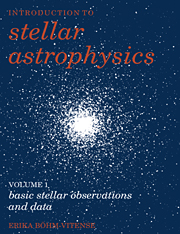Book contents
- Frontmatter
- Contents
- Preface
- 1 Positions of stars
- 2 Proper motions of stars
- 3 Distances of nearby stars
- 4 The brightnesses of the stars
- 5 Color magnitude diagrams
- 6 The luminosities of the stars
- 7 Angular radii of stars
- 8 Effective temperatures of stars
- 9 Masses and radii of stars
- 10 Spectral classification
- 11 Understanding stellar spectra
- 12 Population II stars
- 13 Stellar rotation
- 14 Stellar magnetic fields
- 15 Stars with peculiar spectra
- 16 Pulsating stars
- 17 Explosive stars
- 18 Our sun
- 19 Interstellar absorption
- Appendixes
- References
- Index
16 - Pulsating stars
Published online by Cambridge University Press: 04 August 2010
- Frontmatter
- Contents
- Preface
- 1 Positions of stars
- 2 Proper motions of stars
- 3 Distances of nearby stars
- 4 The brightnesses of the stars
- 5 Color magnitude diagrams
- 6 The luminosities of the stars
- 7 Angular radii of stars
- 8 Effective temperatures of stars
- 9 Masses and radii of stars
- 10 Spectral classification
- 11 Understanding stellar spectra
- 12 Population II stars
- 13 Stellar rotation
- 14 Stellar magnetic fields
- 15 Stars with peculiar spectra
- 16 Pulsating stars
- 17 Explosive stars
- 18 Our sun
- 19 Interstellar absorption
- Appendixes
- References
- Index
Summary
The different types of pulsating stars
The pulsating stars (not to be confused with pulsars, which are rotating not pulsating), are recognized by their periodic changes in brightness accompanied by periodic variations of their radial velocities. We distinguish several classes of pulsating stars. The most frequent type are the δ Cephei stars, which have periods of light variation of a few days to a few weeks. Another very common type is the RR Lyrae star, named after the first-discovered variable of this kind. The RR Lyrae stars vary with periods of the order of half a day. Other types of short period variables are the δ Scuti stars, which are population I variables like the longer period δ Cephei stars. The δ Cephei stars are generally of spectral types F and G, and are supergiants, while the δ Scuti stars are A stars of luminosity class IV to V. The amplitudes of the δ Cephei variables are of the order of one magnitude, i.e., the light output changes by a factor of 2 or 3, while the light variations of the δ Scuti stars are so small that they are hard to detect.
The RR Lyrae stars are frequently found in globular clusters; therefore, they belong to population II. The amplitudes of their light variations are also of the order of one magnitude, and can therefore be recognized fairly easily.
- Type
- Chapter
- Information
- Introduction to Stellar Astrophysics , pp. 153 - 164Publisher: Cambridge University PressPrint publication year: 1989

